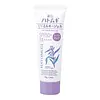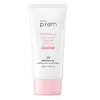KUMANO COSME Hatomugi The Tone Up UV Milky Gel SPF 50+ Versus Make p:rem UV Defense Me. Calming Tone Up Sun Cream
What's inside
What's inside
 Key Ingredients
Key Ingredients

 Benefits
Benefits

 Concerns
Concerns

 Ingredients Side-by-side
Ingredients Side-by-side

Water
Skin ConditioningEthylhexyl Methoxycinnamate
UV AbsorberAlcohol Denat.
AntimicrobialTitanium Dioxide
Cosmetic ColorantDiethylamino Hydroxybenzoyl Hexyl Benzoate
UV FilterOctocrylene
UV AbsorberButylene Glycol
HumectantDimethicone
EmollientSteareth-6
EmulsifyingCarbomer
Emulsion StabilisingAcrylates/C10-30 Alkyl Acrylate Crosspolymer
Emulsion StabilisingPotassium Hydroxide
BufferingSilica
AbrasiveMica
Cosmetic ColorantRosmarinus Officinalis Leaf Extract
AntimicrobialPrunus Persica Leaf Extract
EmollientAloe Barbadensis Leaf Extract
EmollientPimpinella Anisum Seed Extract
AstringentCitrus Junos Peel Oil
AstringentCocos Nucifera Oil
MaskingXanthan Gum
EmulsifyingTetrasodium EDTA
Sodium Hydroxide
BufferingBHT
AntioxidantPhenoxyethanol
PreservativeMethylparaben
PreservativeBlue 1 Lake
Cosmetic ColorantCI 17200
Cosmetic ColorantParfum
MaskingWater, Ethylhexyl Methoxycinnamate, Alcohol Denat., Titanium Dioxide, Diethylamino Hydroxybenzoyl Hexyl Benzoate, Octocrylene, Butylene Glycol, Dimethicone, Steareth-6, Carbomer, Acrylates/C10-30 Alkyl Acrylate Crosspolymer, Potassium Hydroxide, Silica, Mica, Rosmarinus Officinalis Leaf Extract, Prunus Persica Leaf Extract, Aloe Barbadensis Leaf Extract, Pimpinella Anisum Seed Extract, Citrus Junos Peel Oil, Cocos Nucifera Oil, Xanthan Gum, Tetrasodium EDTA, Sodium Hydroxide, BHT, Phenoxyethanol, Methylparaben, Blue 1 Lake, CI 17200, Parfum
Water
Skin ConditioningZinc Oxide
Cosmetic ColorantPropylheptyl Caprylate
EmollientPropanediol
SolventTitanium Dioxide
Cosmetic ColorantDisiloxane
Skin ConditioningDicaprylyl Ether
EmollientButylene Glycol Dicaprylate/Dicaprate
EmollientButyloctyl Salicylate
Skin ConditioningCaprylyl Methicone
Skin ConditioningPolyglyceryl-4 Diisostearate/Polyhydroxystearate/Sebacate
EmulsifyingCalamine
AbsorbentTrimethylsiloxysilicate
EmollientBambusa Vulgaris Water
Skin ConditioningFructan
Skin ConditioningHelianthus Annuus Seed Oil Unsaponifiables
EmollientTocopherol
AntioxidantPyrus Communis Fruit Extract
Skin ConditioningPrunus Persica Fruit Extract
AbrasiveCucumis Melo Fruit Extract
Skin ConditioningHedera Helix Leaf/Stem Extract
AntimicrobialMoringa Oleifera Seed Extract
Skin ConditioningCardiospermum Halicacabum Flower/Leaf/Vine Extract
Skin ConditioningJasminum Officinale Flower/Leaf Extract
MaskingRibes Nigrum Seed Oil
EmollientHelianthus Annuus Seed Oil
EmollientDisteardimonium Hectorite
StabilisingMagnesium Sulfate
Methyl Methacrylate Crosspolymer
Stearic Acid
CleansingAluminum Hydroxide
EmollientTriethoxycaprylylsilane
Polyglyceryl-3 Polydimethylsiloxyethyl Dimethicone
Skin Conditioning1,2-Hexanediol
Skin ConditioningVinyl Dimethicone/Methicone Silsesquioxane Crosspolymer
Polymethylsilsesquioxane
Glyceryl Caprylate
EmollientCaprylyl Glycol
EmollientEthylhexylglycerin
Skin ConditioningOctyldodecanol
EmollientMaltodextrin
AbsorbentButylene Glycol
HumectantWater, Zinc Oxide, Propylheptyl Caprylate, Propanediol, Titanium Dioxide, Disiloxane, Dicaprylyl Ether, Butylene Glycol Dicaprylate/Dicaprate, Butyloctyl Salicylate, Caprylyl Methicone, Polyglyceryl-4 Diisostearate/Polyhydroxystearate/Sebacate, Calamine, Trimethylsiloxysilicate, Bambusa Vulgaris Water, Fructan, Helianthus Annuus Seed Oil Unsaponifiables, Tocopherol, Pyrus Communis Fruit Extract, Prunus Persica Fruit Extract, Cucumis Melo Fruit Extract, Hedera Helix Leaf/Stem Extract, Moringa Oleifera Seed Extract, Cardiospermum Halicacabum Flower/Leaf/Vine Extract, Jasminum Officinale Flower/Leaf Extract, Ribes Nigrum Seed Oil, Helianthus Annuus Seed Oil, Disteardimonium Hectorite, Magnesium Sulfate, Methyl Methacrylate Crosspolymer, Stearic Acid, Aluminum Hydroxide, Triethoxycaprylylsilane, Polyglyceryl-3 Polydimethylsiloxyethyl Dimethicone, 1,2-Hexanediol, Vinyl Dimethicone/Methicone Silsesquioxane Crosspolymer, Polymethylsilsesquioxane, Glyceryl Caprylate, Caprylyl Glycol, Ethylhexylglycerin, Octyldodecanol, Maltodextrin, Butylene Glycol
 Reviews
Reviews

Alternatives
Ingredients Explained
These ingredients are found in both products.
Ingredients higher up in an ingredient list are typically present in a larger amount.
Butylene Glycol (or BG) is used within cosmetic products for a few different reasons:
Overall, Butylene Glycol is a safe and well-rounded ingredient that works well with other ingredients.
Though this ingredient works well with most skin types, some people with sensitive skin may experience a reaction such as allergic rashes, closed comedones, or itchiness.
Learn more about Butylene GlycolTitanium dioxide is a mineral UV filter widely used in sunscreens and cosmetics.
It is one of only two UV filters officially classified as “mineral” by regulatory agencies, the other being zinc oxide.
Titanium dioxide provides broad-spectrum protection mostly in the UVB and UVAII range, with some protection in the UVAI range.
While its UVA protection isn’t as strong as zinc oxide’s, the difference is minor.
A common myth is that mineral UV filters reflect UV light. However, modern research shows titanium dioxide absorbs UV radiation like chemical filters (~95% absorption & 5% reflection).
Thanks to its non-irritating nature, titanium dioxide is suitable for sensitive, acne-prone, or redness-prone skin. It is unlikely to cause "eye sting" like other sunscreen ingredients.
A major drawback of this ingredient is its white cast and thick texture. This is why mineral sunscreens often leave a white cast and are less cosmetically elegant than chemical/hybrid sunscreens.
To improve white cast and spreadability, micronized or nano-sized titanium dioxide is often used.
There are ongoing concerns surrounding nano-titanium oxide's impact on marine ecosystems.
There is no conclusive evidence that any form of titanium oxide (or any other sunscreen ingredients) will cause harm to marine ecosystems or coral reefs. The science is still developing but many consumers are keeping a close eye on this issue.
Please note, many destinations have reef-safety sunscreen rules. For instance, the U.S. Virgin Islands advises all visitors to use non-nano mineral sunscreens.
Nano mineral sunscreens once raised safety concerns about absorption into skin.
Extensive research has shown that they do not penetrate healthy or damaged skin; they remain safely on the surface and the top layer of dead skin (stratum corneum).
You'll likely find titanium dioxide bundled with alumina, silica, or dimethicone. These ingredients help make titanium dioxide highly photostable; this prevents it from interacting with other formula components under UV light.
Learn more about Titanium DioxideWater. It's the most common cosmetic ingredient of all. You'll usually see it at the top of ingredient lists, meaning that it makes up the largest part of the product.
So why is it so popular? Water most often acts as a solvent - this means that it helps dissolve other ingredients into the formulation.
You'll also recognize water as that liquid we all need to stay alive. If you see this, drink a glass of water. Stay hydrated!
Learn more about Water